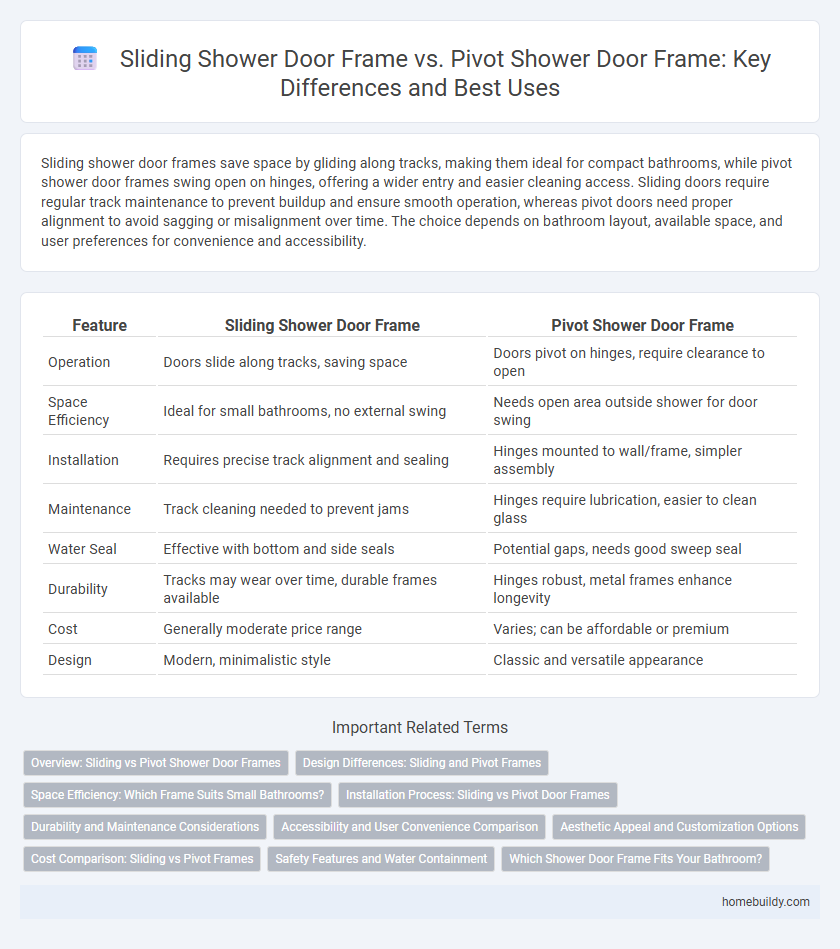Sliding shower door frames save space by gliding along tracks, making them ideal for compact bathrooms, while pivot shower door frames swing open on hinges, offering a wider entry and easier cleaning access. Sliding doors require regular track maintenance to prevent buildup and ensure smooth operation, whereas pivot doors need proper alignment to avoid sagging or misalignment over time. The choice depends on bathroom layout, available space, and user preferences for convenience and accessibility.
Table of Comparison
| Feature | Sliding Shower Door Frame | Pivot Shower Door Frame |
|---|---|---|
| Operation | Doors slide along tracks, saving space | Doors pivot on hinges, require clearance to open |
| Space Efficiency | Ideal for small bathrooms, no external swing | Needs open area outside shower for door swing |
| Installation | Requires precise track alignment and sealing | Hinges mounted to wall/frame, simpler assembly |
| Maintenance | Track cleaning needed to prevent jams | Hinges require lubrication, easier to clean glass |
| Water Seal | Effective with bottom and side seals | Potential gaps, needs good sweep seal |
| Durability | Tracks may wear over time, durable frames available | Hinges robust, metal frames enhance longevity |
| Cost | Generally moderate price range | Varies; can be affordable or premium |
| Design | Modern, minimalistic style | Classic and versatile appearance |
Overview: Sliding vs Pivot Shower Door Frames
Sliding shower door frames save space by gliding along tracks, ideal for compact bathrooms, while pivot shower door frames swing open on hinges, offering wider access and a traditional look. Sliding frames typically require less clearance outside the shower area, making them practical for tight layouts, whereas pivot frames need room for door swing but provide easier cleaning access. Both frame types vary in materials and finishes, impacting durability and design compatibility with bathroom styles.
Design Differences: Sliding and Pivot Frames
Sliding shower door frames feature a dual-track system allowing doors to glide horizontally, optimizing space in compact bathrooms. Pivot shower door frames rotate on hinges, offering a traditional swinging motion that requires clear floor space for open doors. Design differences impact installation flexibility, user accessibility, and bathroom layout adaptation.
Space Efficiency: Which Frame Suits Small Bathrooms?
Sliding shower door frames maximize space efficiency by gliding parallel to the shower enclosure, making them ideal for small bathrooms with limited clearance. Pivot shower door frames require additional space to swing open, which can restrict movement in compact areas. Choosing a sliding door frame optimizes floor space and enhances accessibility in tight bathroom layouts.
Installation Process: Sliding vs Pivot Door Frames
Sliding shower door frames typically require precise alignment of rollers and tracks, making the installation process more intricate and time-consuming compared to pivot door frames. Pivot shower door frames involve fewer components and straightforward hinge attachment, allowing for quicker and simpler installation. Proper measurement and ensuring wall stability remain critical steps for both sliding and pivot door frame installations to guarantee smooth operation and durability.
Durability and Maintenance Considerations
Sliding shower door frames typically feature aluminum or stainless steel tracks that resist corrosion and withstand frequent use, offering enhanced durability compared to pivot frames. Pivot shower door frames, often mounted on hinges, may require more frequent maintenance to ensure smooth operation and to prevent wear on pivot points. Regular cleaning and lubrication extend the lifespan of both types, but sliding door tracks can accumulate debris, necessitating periodic removal for optimal performance.
Accessibility and User Convenience Comparison
Sliding shower door frames maximize accessibility in small bathrooms by requiring minimal clearance space and allowing smooth side-to-side movement, ideal for users with limited mobility. Pivot shower door frames offer wider entry space and easier reach for wheelchair users due to their outward swinging motion, though they need sufficient clearance outside the shower area. Sliding doors suit compact designs prioritizing space efficiency, while pivot doors enhance user convenience with broad entry access and straightforward operation.
Aesthetic Appeal and Customization Options
Sliding shower door frames offer a sleek, modern aesthetic with clean lines that seamlessly integrate into contemporary bathroom designs, while pivot shower door frames provide a classic look that complements traditional spaces. Customization options for sliding frames often include varied track finishes and glass styles, allowing for tailored visual appeal and functionality. Pivot frames typically offer fewer customization choices but can be enhanced with decorative hinges and hardware to match specific bathroom themes.
Cost Comparison: Sliding vs Pivot Frames
Sliding shower door frames generally cost more upfront due to their complex track and roller mechanisms, ranging from $200 to $800 depending on materials and size. Pivot shower door frames tend to be more affordable, with prices typically between $150 and $500, benefiting from simpler hinge systems and easier installation. Long-term maintenance costs for sliding frames can be higher because of track cleaning and roller replacements, whereas pivot frames usually require minimal upkeep.
Safety Features and Water Containment
Sliding shower door frames provide enhanced water containment with overlapping panels and tight seals that prevent leakage more effectively than pivot door frames. Pivot shower door frames offer better safety features through controlled door movement and sturdy hinges that minimize accidental slamming and injury. The choice between sliding and pivot frames depends on prioritizing superior water retention versus smoother, safer door operation.
Which Shower Door Frame Fits Your Bathroom?
Sliding shower door frames maximize space by gliding smoothly along tracks, ideal for compact bathrooms or areas with limited clearance. Pivot shower door frames swing open on hinges, requiring additional floor space but offering a wider entry, suitable for larger rooms or users needing easier access. Choosing the right shower door frame depends on bathroom size, layout, and user convenience preferences, ensuring efficient use of space and optimal functionality.
Sliding shower door frame vs pivot shower door frame Infographic

 homebuildy.com
homebuildy.com